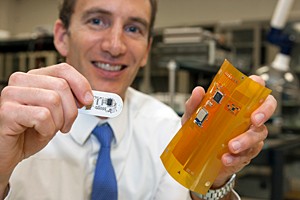
HELLO? Sweat and a Smartphone Could Become The Hot New Health Screening
A University of Cincinnati partnership is reporting a significant leap forward in health diagnostics that are more accurate than whats available today, yet considerably less invasive than something like a blood screening. Its a lightweight, wearable device that analyzes sweat by using a smartphone.
In an article published in the latest issue of
, Jason Heikenfeld, a UC professor of electrical engineering and computing systems, highlights new developments regarding the gadget that can gather vital medical information in almost real time.
With that kind of information, athletes could avoid the killer cramps that could cause them to be carried off the field at the peak of their game or competition. Preemies vitals could be monitored without drawing blood the pain and blood loss causing even more stress on a physically-stressed infant. One day, diabetics could maybe even avoid those painful sticks as well, as they check their glucose levels.
Heikenfeld says the patches are as light and flexible as a BAND-AID® and use paper microfluidics an inexpensively developed technology similar to that of a home pregnancy test to collect and gather biomarkers carried in sweat. Those biomarkers electrolytes, metabolites, proteins, small molecules, amino acids and such can signal the physical state of the body.
In athletes for example, a drop in electrolytes can cause those paralyzing cramps. Athletes want to constantly push their athletic training to the absolute limit. But its hard to tell when youre pushing too far, when youre basically causing tissue damage, and this will tell you that, says Heikenfeld. The newer patches in development are also meant to measure recovery from stress, which in many cases is more important initially than measuring the stressors themselves. One example goal is to measure cortisol levels and tell you how they return to normal over time.
Heikenfeld writes that the paper in the patch wicks sweat in a tree-root pattern, maximizing the collection area while minimizing the volume of paper. The researchers built a sodium sensor, voltage meter, communications antenna, microfluidics and a controller chip onto the patch that is externally powered by the smartphone.

The next generation of sweat sensor pad and flexible Bluetooth circuit.
Heikenfeld says industry partners are expected to start more extensive human trials with the patch before the end of the year. Pilot program testing on college athletes could begin early next year. Heikenfeld adds in the article that a second-generation patch using secure Bluetooth technology is nearly complete.
The partnership is an example of UCs
Creating Our Third Century initiatives
to create pathways to the future by blending UCs premiere research talent and discoveries with industry partnerships and commercialization.
Heikenfeld says future applications for the patch could involve drug monitoring. A lot of drug metabolites come out of sweat, so by using this technology, doctors can help patients take drug dosages more evenly. Our current methods, often based on age or body weight, are extremely crude when you think about all the side effects listed on the warning labels.
Ultimately, sweat analysis will offer minute-by-minute insight into what is happening in the body, with on-demand, localized, electronically stimulated sweat sampling in a manner that is convenient and unobtrusive, Heikenfeld concludes in the article.
Bill Ball, UCs vice president for research, adds, This has been the result of years of effort, benefiting from UCs long-standing commitment to research in skin science and technology, and as a result, overcoming hurdles that may have prevented success by others in the past.
Heikenfeld is head of UCs
, dedicated to multidisciplinary research, primarily in electrofluidics and biosensors, spanning fundamental science to more applied work through industrial partnerships.
The sweat sensor technology research is a partnership that includes UCs College of Engineering and Applied Science (with co-researchers Ian Papautsky, professor of electrical engineering and computer systems, and Fred Beyette, professor of electrical engineering and computer systems); the James L. Winkle College of Pharmacy (with co-researchers Gerald Kasting, professor of pharmaceutical sciences, and Kevin Li, professor of pharmaceutical sciences); the UC College of Medicine, the Air Force Research Lab (AFRL), UCs Office of Office of Entrepreneurial Affairs and Technology Commercialization, and numerous industries, including those represented in UCs new National Science Foundation-funded Center for Advanced Design and Manufacturing of Integrated Microfluidics
.
IEEE Spectrum is the flagship magazine of the IEEE. With more than 400,000 members, the IEEE is the worlds largest professional organization devoted to engineering and the applied sciences.
Related Stories
UC Honors students gain hands-on research experience
April 1, 2025
The Biomedical Research and Mentoring Program is open to any University Honors Program students. The faculty mentors are typically from UC’s College of Medicine or Cincinnati Children's Hospital.
UC doctor patenting first at-home endometriosis diagnostic test
March 31, 2025
March is endometriosis awareness month. Endometriosis is a condition that can be debilitating and is estimated to affect more than 6 million women in the U.S. Endometriosis occurs when tissue similar to the lining of the uterus grows outside of the uterus, causing pain, inflammation and potential infertility. The road to a diagnosis has been challenging for many women, but a University of Cincinnati researcher has developed a noninvasive diagnostic test that could make a difference.
UC engineer applying generative AI to smart manufacturing
March 31, 2025
Manish Raj Aryal, a PhD student in mechanical engineering at the University of Cincinnati, is working on revolutionizing manufacturing systems through generative AI, leveraging AI systems to develop manufacturing assistant chatbots. He came to UC for his master's degree and continued researching as a PhD student. He was named Graduate Student Engineer of the Month by the College of Engineering and Applied Science (CEAS).
